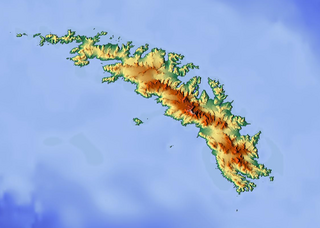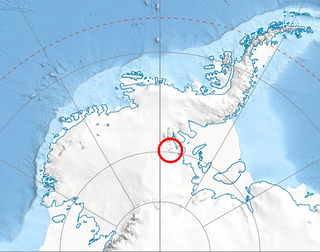
Minnesota Glacier is a broad glacier, about 40 nautical miles long and 5 nautical miles wide, flowing east through the Ellsworth Mountains in Antarctica, separating the Sentinel Range and the Heritage Range. It is nourished by ice from the plateau west of the mountains and by Nimitz Glacier and Splettstoesser Glacier, and merges into the larger Rutford Ice Stream at the eastern margin of the Ellsworth Mountains.

Quensel Glacier is a small glacier flowing southeast into Cooper Bay at the east tip of South Georgia. It was named by the United Kingdom Antarctic Place-Names Committee (UK-APC) after Percy D. Quensel, Swedish geologist of Uppsala University, who visited South Georgia with Carl Skottsberg in 1909.

Carey Glacier is a glacier on the east side of Miller and Fruzhin Peaks and west of Ruset and Malkoch Peaks in Petvar Heights at the southeast end of the Sentinel Range, Ellsworth Mountains, flowing southeast to Minnesota Glacier. It was mapped by the United States Geological Survey from surveys and from U.S. Navy air photos, 1957–59, and named by the Advisory Committee on Antarctic Names for Lieutenant David W. Carey, pilot with U.S. Navy Squadron VX-6, who was killed in the crash of a P2V Neptune airplane at McMurdo Sound in October 1956.
Carnell Peak is a peak, 1,730 metres (5,680 ft) high, in the Watlack Hills, situated 2.5 nautical miles (5 km) from the southeast end of the group, in the Heritage Range, Ellsworth Mountains. It was mapped by the United States Geological Survey from surveys and from U.S. Navy air photos, 1961–66, and named by the Advisory Committee on Antarctic Names for Lieutenant D.L. Carnell, Civil Engineer Corps, U.S. Navy, maintenance officer at Williams Field, McMurdo Sound, in the 1965–66 season, who was responsible for the first piercing of the Ross Ice Shelf at 50 meters.

Owen Ridge is a very high and rugged mountain ridge, 22 nautical miles (41 km) long, which forms the southwesternmost element of the Sentinel Range, Ellsworth Mountains. It extends south-southeast from Karnare Col and includes Mount Strybing, Mount Southwick and Lishness Peak, ending up in Bowers Corner. Mapped by United States Geological Survey (USGS) from surveys and U.S. Navy aerial photography, 1957-60. Named by Advisory Committee on Antarctic Names (US-ACAN) (1974) for Thomas B. Owen, Assistant Director of National and International Programs, National Science Foundation.
Nimbus Hills is a rugged line of hills and peaks about 14 nautical miles (26 km) long, forming the southeast part of Pioneer Heights in the Heritage Range, Ellsworth Mountains. Mapped by United States Geological Survey (USGS) from ground surveys and U.S. Navy air photos, 1961-66. Named by Advisory Committee on Antarctic Names (US-ACAN) after the National Aeronautics and Space Administration weather satellite, Nimbus, which took photographs of Antarctica from approximately 500 nautical miles (900 km) above earth on September 13, 1964.
Kosco Peak is a prominent rock peak in the northern part of the Edson Hills, rising to about 1,650 metres (5,400 ft) between Drake Icefall and Hyde Glacier, in the Heritage Range, Ellsworth Mountains, Antarctica. It was mapped by the United States Geological Survey (USGS) from surveys and U.S. Navy aerial photographs from 1961–66, and was named by the Advisory Committee on Antarctic Names after William J. Kosco. Kosco was a topographic engineer at the USGS from 1952–83 and was chief of the Polar Programs Office from 1975–83, with responsibility for Antarctic mapping.
Pioneer Heights is a group name in the Heritage Range, Ellsworth Mountains, encompassing the large area of hills, ridges and peaks located eastward of Schneider and Schanz Glaciers and between Splettstoesser and Union Glaciers. Among these features are the Inferno Ridge, the Nimbus Hills, Gross, Buchanan and Collier Hills. The Pioneer Heights were mapped by the United States Geological Survey (USGS) from ground surveys and U.S. Navy air photos from 1961-66. The name was applied by the Advisory Committee on Antarctic Names (US-ACAN) in association with the name Heritage Range.

Drake Icefall is an icefall 2 nautical miles (4 km) wide between the Soholt Peaks and the Edson Hills in Antarctica, draining eastward from the plateau to join the general flow of Union Glacier through the Heritage Range, Ellsworth Mountains. It was named by the University of Minnesota Ellsworth Mountains Party, 1962–63, for Benjamin Drake IV, a geologist and member of the party.

Fendorf Glacier is a broad glacier draining from the eastern slopes of the Gifford Peaks and flowing north to merge with Dobbratz Glacier, in the Heritage Range of the Ellsworth Mountains, Antarctica. It was mapped by the United States Geological Survey from ground surveys and U.S. Navy air photos, 1961–66, and was named by the Advisory Committee on Antarctic Names for Lieutenant Commander James E. Fendorf, U.S. Navy, a pilot with Squadron VX-6 during Operation Deep Freeze 1966.

Mount Hubley is a prominent, snow-covered, outlying mountain to the west of Mount Hale, in the Sentinel Range of the Ellsworth Mountains in Antarctica. It was first mapped by the United States Geological Survey from surveys and U.S. Navy air photos from 1957–59, and was named by the Advisory Committee on Antarctic Names for Richard C. Hubley, a member of the Technical Panel on Glaciology in the U.S. National Committee for the International Geophysical Year.
Hudak Peak is a peak rising to 1,440 metres (4,720 ft) immediately south of Plummer Glacier in the Douglas Peaks of the Heritage Range, in the Ellsworth Mountains of Antarctica. It was named by the Advisory Committee on Antarctic Names in 2004 after Curtis M. Hudak, a geologist on the United States Antarctic Research Program 1979–80 Ellsworth Mountains expedition.
Mount Hirman is a prominent mountain marking the southern end of the Behrendt Mountains, in Ellsworth Land, Antarctica. It was mapped by the United States Geological Survey from surveys and U.S. Navy air photos from 1961–67, and was named by the Advisory Committee on Antarctic Names for Joseph W. Hirman, a scientific leader at Eights Station in 1965.
Mount Macalester is a prominent peak rising to 2,480 metres (8,140 ft) in the central part of the Soholt Peaks, Heritage Range, Ellsworth Mountains, Antarctica. It was mapped by the United States Geological Survey from surveys and U.S. Navy aerial photographs from 1961–66. The peak was named by the Advisory Committee on Antarctic Names after Macalester College, the alma mater of Gerald F. Webers, the leader of the United States Antarctic Research Program Ellsworth Mountains Expedition of 1979–80. It was first climbed on December 28, 2013 by Ralf Laier, Pachi Ibarra and Seth Timpano in Alpine style during their traverse of the Soholt Peaks.
Rosen Peak is a peak rising to 1220 m in the south part of Gross Hills, Heritage Range, Ellsworth Mountains. It was named by the Advisory Committee on Antarctic Names (US-ACAN) (2004) after Lawrence C. Rosen, a geologist on the United States Antarctic Research Program (USARP) Ellsworth Mountains expedition of 1979-80.

Mount Landolt is a mountain, 2,280 metres (7,480 ft) high, standing at the head of Hudman Glacier in the Petvar Heights at the southeastern extremity of the Sentinel Range in the Ellsworth Mountains of Antarctica. It was first mapped by the United States Geological Survey from surveys and U.S. Navy air photos from 1957–59, and was named by the Advisory Committee on Antarctic Names for Arlo U. Landolt, an aurora scientist at the International Geophysical Year South Pole Station in 1957.
Linder Peak is a somewhat lower but very imposing peak standing immediately south of Mount Dolence in the Heritage Range, Ellsworth Mountains, Antarctica. It was mapped by the United States Geological Survey from surveys and U.S. Navy air photos from 1961–66, and was named by the Advisory Committee on Antarctic Names for Harold W. Linder, a geophysicist with the United States Antarctic Research Program Ross Ice Shelf party of 1961–62.

Schmidt Glacier is a glacier, 20 nautical miles long, in the Pioneer Heights of the Heritage Range, Ellsworth Mountains in Antarctica. The glacier originates near Hall Peak and drains north along the west side of Thompson Escarpment and Gross Hills to coalesce with the lower part of Splettstoesser Glacier, north of Mount Virginia. It was named by the University of Minnesota Ellsworth Mountains Party, 1961-62, for Paul G. Schmidt, geologist with the party.









